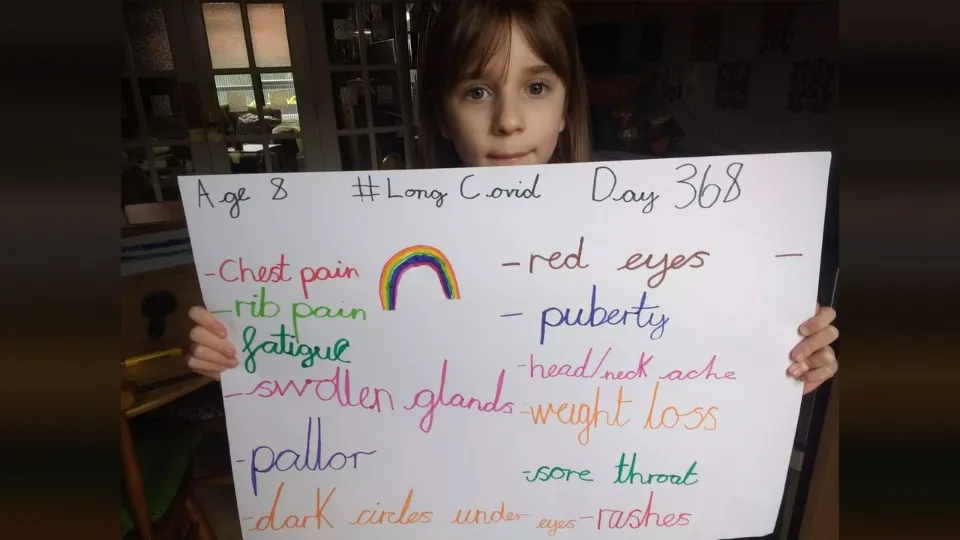The “mass disabling event” of the One of the largest social crimes of the 20th century is the Long COVID disaster, which the capitalist ruling elites of the world are responsible for. They have not only caused the needless deaths of over 20 million people, but they have also condemned tens of millions of other people to a life of deprivation and uncertainty. Children and the elderly are especially at risk from Long COVID’s effects.
If any society can be judged by how it treats its most vulnerable members, especially children who are the promise of humanity’s future, then by this criterion, the policy of “herd immunity” or “living with the virus” is a complete indictment of capitalism.
Even though it can be difficult to comprehend, any realistic evaluation of the pandemic must acknowledge that the COVID-19 pandemic has been viewed as a good by the majority of the ruling elite because it has decreased life expectancy and decreased the need for pensions. Eugenicist conceptions of “survival of the fittest,” suppressed for decades after the horrors of Holocaust denial and the revival of World War II have permeated all bourgeois media.
In Britain, the tory government’s class war budget combined with the somber reality of the death toll led to an estimated reduction in pension spending of 600 million pounds in 2020–2021 and 900 million pounds in 2021/22. Due to an increasing number of pensioner deaths this year, the current savings will be even higher. The same trends have developed globally.
Most recently, capitalist politicians around the world started a form of historical revisionism by making the false claim that the limited lockdowns and other public health measures put in place at the beginning of the pandemic were actually an overreach and did more harm than good. They are steadfastly committed to preventing any pandemics in the future, which scientists have warned are more likely to occur in the upcoming years. The most helpless people will still be left to fend for themselves under capitalism.
Long COVID and Children
Children’s Long COVID research is still in its infancy. Estimates of the condition’s prevalence and the probable length of symptoms range widely. Children who had minimal or no symptoms at the time of their initial infection, like adults, can develop Long COVID.
On behalf of the ruling elite, in the first year of the pandemic the corporate media disseminated the lie that children could not get COVID, or that if they did the symptoms were universally “mild.” Most infamously, at a CNN town hall event in February 2021, US President Joe Biden told a second grader, “Young children rarely contract COVID. It’s uncommon for that to occur.” He added, “In the entire world, you are among the most secure individuals.”
This lie, which was used to support the full reopening of schools so that parents could return to the workforce and generate profits, had already been thoroughly debunked by a number of scientific studies.
129 children aged 6 to 16 who contracted COVID-19 between March and November 2020 in northern Italy were interviewed by Danilo Buonsenso, a paediatrician at the Gemelli University Hospital in Rome, who first raised concerns about Long COVID’s effects on children.
Insomnia, exhaustion, muscle pain, and complaints resembling a persistent cold were among the symptoms listed by Buonsenso, which were also common in adult patients. Such descriptions hardly do justice to how crippling the condition is.
The World Health Organization released a comment in August 2020 that detailed Kitty McFarland’s, a 14-year-old who had contracted COVID in March 2020, Long COVID experience. She used to be in excellent physical shape, enjoy running, netball, ballet, and paddleboarding.
Kitty only initially experienced mild symptoms with a cough and flu-like fever, but later became “unresponsive.” After a few days, this diminished, and she seemed to be feeling better. She tried some very light exercise about a month later, but as a result, she was confined to bed for eight months.
“I was mostly exhausted and dizzy. I would faint a lot and get heart palpitations; I could be just sitting around, and my heart would suddenly leap to 190 beats a minute,” said Kitty later experienced severe abdominal pain that made her dizzy and necessitated multiple hospital stays. She also developed a gluten intolerance.
“Sometimes I needed help to eat all my food; at other times, I couldn’t physically lift a glass because I was so weak, which is hard to admit when you were used to being strong and active,” she related.
Even trying to watch TV or send a text while experiencing visual disturbances and brain fog made Kitty feel sick to her stomach and worn out. Long COVID Kids was established in Britain by her mother Sammie.
Research published inNature Scientific Reports last According to a June estimate by Novartis Pharmaceuticals, Sandra Lopez-Leon, 25.4% of children and adolescents are susceptible to Long COVID. At least 80,000 kids in the UK are thought to have Long COVID.
The Omicron variant that emerged in November 2021 was immediately heralded as “mild” without a shred of evidence. The Australian government’s Chief Medical Officer Paul Kelly phrased this sentiment in the crudest manner, branding the surge as a “very good Christmas present.“ Thousands of Australians would later perish in the ensuing Omicron surge, and tens of thousands more, including children, would become Long COVID-invalid.
Due to the increasing infectiousness of each new subvariant, Omicron has turned out to be disastrous for kids. Data indicate that a higher percentage of kids were infected by the Omicron BA.2 subvariant in particular.
In February 2022, when the BA.2 outbreak in Hong Kong was at its worst, 1,147 kids were hospitalized with COVID-19, and four of them passed away. The number of kids who were asymptomatic or showing no symptoms is unknown, but they represented a new group of potential Long COVID cases.
Carlos Oliveira, a pediatrician at the Yale New Haven Children’s Hospital, told the BBC in February 2022, “For instance, our hospital has already seen more than three times as many children and teenagers this month than we did during the summer months with post-Covid conditions. Similar patterns are being observed in other nations.”
Children who are infected are thought to develop Long COVID in 10% of cases, according to pediatricians running Long COVID clinics, the BBC reported in March 2022.
The Long COVID in children and adults may be different, according to scientific speculation. Children usually do not experience brain fog, and fatigue is the most common symptom.
According to Oliveira, Long COVID in children is not brought on by antibody problems. He told the BBC last year, “If autoantibodies are the primary cause of this disease, they should be produced at the same rate regardless of age, which would result in a constant prevalence of long-term Covid. However, this is not the case as children have a lower prevalence.”
Oliveira hypothesized that young children with post-Covid inflammation have a biomarker linked to a leaky gut, a digestive condition in which microbes from the gut seep into the bloodstream, in their blood. He thought that COVID-19 was primarily a gastrointestinal issue in children, stating, “It makes sense that being suddenly re-exposed to dead virus due to a leaky gut will cause an inflammatory response because we know that both children and adults can shed the virus’ DNA in their stools for months at a time.”

Research published last August in The Journal of the American Medical Association (JAMA) Paediatrics by infectious disease specialist at In an exploratory study, Suchitra Rao from Children’s Hospital Colorado and his team used a polymerase chain reaction (PCR) test to check 659,286 kids for the presence of SARS-CoV-2 antigens.
The children displayed symptoms such as loss of taste or smell, chest pain, tiredness or malaise, cardiorespiratory symptoms, fever or chills, which were similar to those in adults, according to the researchers. They noted that children exhibited “other features, such as abnormal liver enzymes, hair loss, skin rashes, and diarrhea, which occurred more commonly in children in the 1 to 6 months after SARS-CoV-2 infection…” Myocarditis, an inflammation of the heart’s lining, was discovered by Rao to be the condition most frequently linked to childhood COVID-19 infection.
“We concluded that many of the symptoms children experience post-COVID-19 are similar to what is seen in adults, but there are some features more unique to children, such as myocarditis, abnormal liver enzymes, hair loss, skin rashes and diarrhea,” Rao told Science Daily.
Rae Duncan gave a very stern warning about the potential dire future for children with Long COVID associated with endothelial dysfunction brought on by inflammation of the blood vessel lining at the conclusion of her presentation on the effects of Long COVID on the cardiovascular system last September, as described above. This has been shown to be a factor in future atherosclerosis (plaque or artery blockages), heart attacks, and strokes.
“I do not want our kids to be repeatedly infected every three to six months with this illness [COVID] and end up potentially, we don’t know this for certain, but with blood vessels of a 90-year-old by the time they are 40,” Duncan warned.
Long COVID is not the only illness that many COVID-19 patients have gone on to develop; many also go on to develop MIS-C, or multi-system inflammatory syndrome in children, which typically develops 2–6 weeks after infection. The long-term sequelae and effects of MIS-C on children can be fatal and incapacitating, despite not being the same as Long COVID. More research is needed for both conditions, but it is currently not nearly sufficiently funded.
Long COVID in Older People
Only a very small number of studies have been done to examine the precise effects of Long COVID on older individuals, and this research is still in its infancy. What is becoming clear is that it has resulted in disaster for many elderly members of society, whose physical and mental health may be severely impacted, consigning them to a very precarious existence.
A Washington Post article published last June focused on the COVID-19 patient Terry Bell, 70, who spent weeks in the hospital 18 months after contracting the virus. Routine tasks like hanging his clothes up are challenging for him. He is out of breath and exhausted to the point of weakness. Since his initial infection, he has lost 50 pounds and can only walk short distances with a cane.



